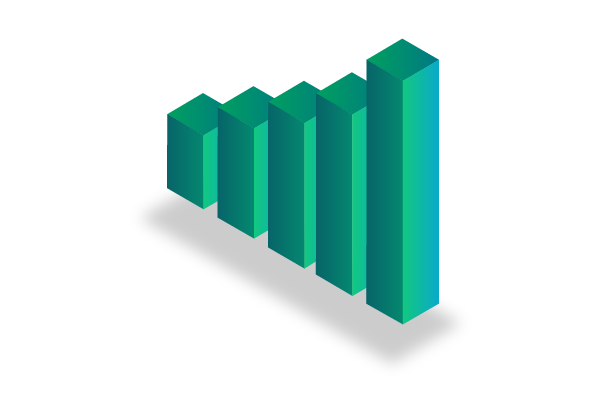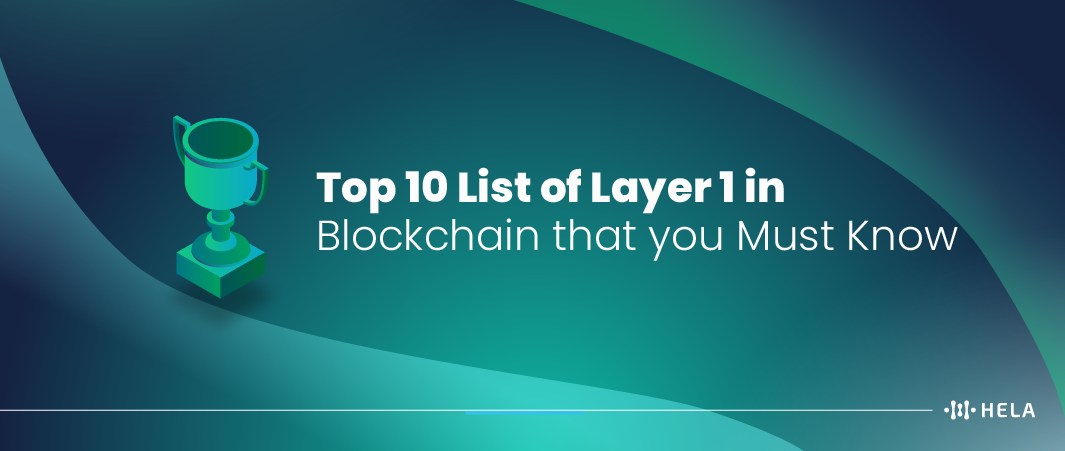The blockchain realm, with its myriad of possibilities, is anchored by its foundational layers. Layer 1, often termed the ‘base layer’, is where the primary operations of blockchain occur. This article aims to spotlight the top 10 Layer 1 platforms that are not only pivotal in the decentralized domain but are also redefining the potential of blockchain technology.
With the surge in demand for decentralized applications (dApps) and smart contracts, the significance of a robust Layer 1 solution is more pronounced than ever. These platforms act as the pillars of the blockchain ecosystem, ensuring security, scalability, and decentralization. Let’s embark on a journey through the top Layer 1 in blockchain platforms and then delve deeper into the broader aspects of blockchain.
Top 10 List of Layer 1 in Blockchain

Layer 1 in blockchain technology refers to the foundational protocol layer of a blockchain network. It is responsible for defining the core features and functionalities of the blockchain, including consensus mechanisms, data structure, and security protocols.
Layer 1 solutions aim to provide a strong base upon which various decentralized applications (dApps) can be built. Here’s a list of the top Layer 1 blockchain projects that have gained prominence in the blockchain ecosystem:
1. HeLa (HLUSD)
HeLa envisions Web 3.0 as a paradigm shift that empowers individuals by granting them full autonomy over their digital assets and data. This vision materializes through a robust decentralized identity management system, instilling unwavering trust and security in all transactions. Championing a user-centric ethos, this approach not only elevates overall experiences but also nurtures a profound sense of ownership within the blockchain ecosystem.
Notably distinguished as the top layer 1 in blockchain protocols, HeLa pioneers cutting-edge privacy safeguards, artfully striking the delicate balance between confidentiality and transparency to seamlessly align with regulatory prerequisites. With its foundational framework as a Layer 1 blockchain protocol, HeLa’s potential finds application across diverse domains such as finance and supply chain management, poised to ingeniously reshape interactions within the decentralized digital realm of Web 3.0.
2. Bitcoin (BTC)
The pioneer, Bitcoin, emerged in 2009 as the inaugural cryptocurrency, setting the stage for decentralized digital currencies and introducing the world to the immense potential of blockchain technology.
Serving as the top layer 1 in blockchain innovation, Bitcoin not only revolutionized the concept of digital money but also paved the way for a global movement towards secure, transparent, and immutable transactions, sparking the development of a diverse ecosystem of cryptocurrencies and decentralized applications that continue to shape the financial and technological landscape.
3. Ethereum (ETH)
A trailblazer in smart contracts and decentralized applications (dApps), Ethereum has profoundly expanded the horizons of blockchain capabilities, earning its reputation as the top layer 1 in blockchain technology. With its innovative approach, Ethereum introduced a new paradigm for programmable and self-executing contracts, empowering developers to create a wide array of decentralized applications that span from finance and gaming to digital art and beyond.
Its robust ecosystem and community-driven development have catalyzed the evolution of blockchain technology, making Ethereum a pivotal force in shaping the decentralized future.
4. Solana (SOL)
Renowned as a developer’s delight, Solana stands out in the blockchain landscape as a top layer 1 solution, celebrated for its exceptional combination of rapid transaction speeds and affordability.
Its high-performance architecture not only paves the way for seamless decentralized applications but also solidifies its position as a favored platform for innovative projects seeking to harness the potential of blockchain technology.
5. BNB (BNB)
Rising from the foundation of the Binance ecosystem, BNB Chain has earned its place as a leading Layer 1 blockchain, recognized for its blend of speed, scalability, and developer-friendly infrastructure. Its EVM compatibility enables seamless migration of Ethereum-based applications, while its robust performance ensures an accessible environment for builders and users alike.
By combining low transaction costs with a thriving ecosystem of DeFi protocols, NFTs, and Web3 innovations, BNB Chain continues to drive adoption across diverse sectors of blockchain technology. This strategic positioning not only underscores its strength as a high-performance network but also highlights its role as a central hub for the next wave of decentralized applications and digital economies.
6. Cardano (ADA)
Merging groundbreaking research with a steadfast commitment to sustainability, Cardano’s innovative proof-of-stake mechanism stands as a resolute nod to the future of blockchain technology.
As a top layer 1 in blockchain, Cardano’s approach not only addresses the energy-intensive concerns associated with traditional proof-of-work systems but also paves the way for heightened efficiency and scalability, positioning itself as a pioneering solution that harmonizes cutting-edge research with a more sustainable and scalable blockchain ecosystem.
7. TRON (TRX)
Distinguished by its unwavering focus on efficiency and accessibility, TRON has emerged as a prominent Layer 1 blockchain, designed to deliver high throughput and minimal transaction costs. Its architecture empowers developers to build decentralized applications with ease, while offering users a seamless experience across payments, smart contracts, and digital content sharing.
With a global footprint and widespread adoption in stablecoin transactions, TRON continues to reinforce its position as a practical and scalable blockchain solution. By enabling fast, low-cost transfers and fostering a vibrant ecosystem of dApps, it stands as a testament to blockchain’s ability to bridge mainstream utility with decentralized innovation.
8. Hyperliquid (HYPE)
Hyperliquid positions itself at the forefront of blockchain innovation as a next-generation Layer 1, purpose-built to deliver unmatched speed and efficiency for decentralized trading. With its custom architecture designed to minimize latency and maximize throughput, Hyperliquid creates an environment where traders and developers alike can rely on performance without compromise.
By blending scalability with advanced trading infrastructure, Hyperliquid is shaping a new era for decentralized finance. Its ability to process transactions at lightning pace while maintaining security and decentralization not only elevates the user experience but also establishes it as a pioneering Layer 1 tailored to the demands of modern markets.
9. Sui (SUI)
Engineered with a focus on speed and scalability, Sui has quickly distinguished itself as a cutting-edge Layer 1 blockchain built to support the next generation of decentralized applications. Leveraging its object-centric data model and parallel execution, Sui delivers lightning-fast transactions and a developer framework that opens new possibilities for interactive and dynamic on-chain experiences.
By prioritizing low latency and horizontal scalability, Sui not only enhances user performance but also fosters an ecosystem where gaming, DeFi, and digital assets can thrive without compromise. This unique approach positions Sui as a pioneering force in redefining how blockchains handle both efficiency and creativity in the Web3 era.
10. Bitcoin Cash (BCH)
Born as a fork of Bitcoin, Bitcoin Cash established itself as a Layer 1 blockchain dedicated to delivering fast, reliable, and cost-effective peer-to-peer transactions. By increasing block size, Bitcoin Cash enhances throughput, making everyday payments practical while staying true to the original vision of cryptocurrency as digital cash.
With its focus on usability and efficiency, Bitcoin Cash continues to serve as a decentralized payment network that prioritizes accessibility on a global scale. Its commitment to low fees and scalable infrastructure not only strengthens its role in digital commerce but also reaffirms its position as a blockchain built for mass adoption.
Also Read: 10 Best Layer 1 Solutions You Need to Know Now!
The Evolution of Blockchain: From Bitcoin to DApps

The evolution of blockchain technology has been nothing short of remarkable, extending far beyond its origins as a mere ledger for Bitcoin transactions. Initially introduced as the underlying technology for cryptocurrencies, blockchain has since undergone a series of transformative developments that have reshaped various industries. Emerging from the shadows of Bitcoin, blockchain’s potential to revolutionize data security, transparency, and decentralization has become increasingly apparent. With the establishment of top layer 1 in blockchain networks like Ethereum, new horizons were unlocked. Ethereum’s innovation of smart contracts propelled blockchain into the realm of programmable transactions, enabling self-executing agreements with far-reaching applications, from supply chain management to decentralized finance.
Also Read: 15 Best Liquid Staking Platforms to Consider in 2025
These advancements gave birth to decentralized applications (dApps), marking another pivotal milestone in the blockchain journey. dApps leverage the underlying blockchain infrastructure to create a decentralized digital ecosystem, enabling functions beyond traditional financial transactions. The synergy between blockchain, smart contracts, and dApps has fostered experimentation and innovation, driving the exploration of novel use cases such as non-fungible tokens (NFTs), decentralized autonomous organizations (DAOs), and more.
As top layer 1 in blockchain continues to evolve, scalability and energy efficiency have become focal points, prompting the development of solutions like proof-of-stake (PoS) consensus mechanisms to address the limitations of early blockchain iterations. The transformative odyssey of blockchain—from its beginnings as a Bitcoin appendage to its role as a catalyst for decentralized innovation—stands as a testament to its potential to reshape the technological landscape.
The Future of Layer 1: Challenges and Opportunities

Top layer 1 in blockchain platforms play a pivotal role as foundational infrastructures, but their ascent is not devoid of challenges. Scaling hurdles emerge as a foremost concern, with growing user demands straining transaction throughput and causing network congestion. These challenges necessitate innovative consensus mechanisms and sharding techniques to enhance scalability without compromising on security and decentralization. Moreover, energy consumption remains a pressing issue, garnering criticism for its environmental impact.
To address this, the blockchain community is actively exploring alternative consensus algorithms, such as Proof of Stake (PoS), which significantly reduces energy consumption compared to the traditional Proof of Work (PoW) model. Additionally, advancements in Layer 1 solutions are forging the path towards more efficient smart contract execution and interoperability, as these platforms strive to establish seamless connections with other blockchains and external systems. Through collaborative efforts and technological innovations, the blockchain community envisions overcoming these challenges and propelling top layer 1 platforms towards a more sustainable and scalable future.
Conclusion
The blockchain revolution is not merely a fleeting technological trend; it signifies a profound paradigm shift poised to reshape industries across the globe. At its core, this transformation hinges on the capabilities of top layer 1 blockchain platforms, which serve as the essential foundation for the decentralized future we envision. These platforms lay the groundwork, offering the fundamental infrastructure that empowers developers, investors, and enthusiasts to leverage the full potential of blockchain technology.
In this dynamic landscape, being well-versed in the intricacies of these layer 1 platforms is of paramount importance. Whether you’re a seasoned developer crafting innovative applications, an astute investor seeking new opportunities, or an impassioned advocate of blockchain’s potential, keeping pace with the evolving ecosystem is a strategic imperative. As we stand on the brink of a groundbreaking era, understanding the nuances of top layer 1 blockchain platforms equips us to navigate and harness the immense promise that this transformative technology holds.
Disclaimer : The information provided by Hela Labs in this article is intended for general informational purposes and does not reflect the company’s opinion. It is not intended as investment advice or recommendations. Readers are strongly advised to conduct their own thorough research and consult with a qualified financial advisor before making any financial decisions.

Joshua Soriano
I am a writer specializing in decentralized systems, digital assets, and Web3 innovation. I develop research-driven explainers, case studies, and thought leadership that connect blockchain infrastructure, smart contract design, and tokenization models to real-world outcomes.
My work focuses on translating complex technical concepts into clear, actionable narratives for builders, businesses, and investors, highlighting transparency, security, and operational efficiency. Each piece blends primary-source research, protocol documentation, and practitioner insights to surface what matters for adoption and risk reduction, helping teams make informed decisions with precise, accessible content.
- Joshua Soriano#molongui-disabled-link
- Joshua Soriano#molongui-disabled-link
- Joshua Soriano#molongui-disabled-link
- Joshua Soriano#molongui-disabled-link

